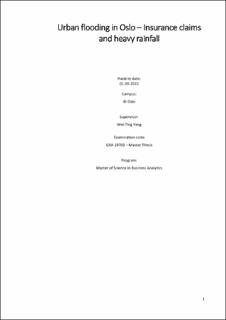| dc.description.abstract | Urban flooding events and damages to private and public buildings and infrastructure is expected to increase due to higher frequency of heavy rainfall. Even if all countries were to fulfill their declared reductions in emission of greenhouse gases in accordance with the Paris agreement and limit the increase in global mean temperature to 1.5°C, more extreme weather is likely to occur. Cities are especially vulnerable to flooding of infrastructure and buildings and basements from run-off after heavy rainfall. Adaptation measures could reduce these damages but are costly. Thus, there is a need to document the correlation between heavy rainfall and damage cost to show the benefit to society in terms of avoided damage costs from adaptation. This is of interest of both insurance companies and the affected businesses, municipalities and households.
This thesis adds to the scare literature on the correlation between precipitation and the damage costs from urban flooding by analyzing a unique dataset of daily insurance claim payments covering rainfall-related damages in Oslo over a 13-year period from 2008 to 2020 from the Norwegian insurance companies and good quality meteorological data from a set of weather stations in Oslo during the same period.
Data on insurance claims from business and households and the associated damage costs from the VASK data base of Finance Norway was used. Efforts were made to isolate urban flooding related damages from other water-related damages by applying combinations of coding of the damages. A sensitivity analysis of a less strict coding practice was also performed, in order to validate the damage coding.
Different rainfall indicators have been used and the results show that both for daily and weekly data of the number of insurance claims and the resulting damage costs, precipitation (in mm) that day/week and the preceding week have a significant (at the 5 % level) leading to increased number of insurance claims and damage costs. Precipitation the preceding month and the second and third week before the incident were included in the models, but precipitation more than one week before the incident was not significant.
Using the number of extreme rain days (defined as more than 20 mm precipitation per day) instead of the amount of precipitation per week, had a significant effect on both the number of insurance claims and damage costs; both per day and per week.
As damage costs from urban flooding are highest in August followed by September and October, seasonal dummy variables were also tested; showing that Summer (June-
August) and in some cases Autumn (September-November) had a significant effect on damage costs.
In conclusion, there is a clear correlation between rainfall and insurance claims, both in terms of numbers and costs. The explanatory power of the best models is, however, only around 20 % (in terms of adjusted R-square). This indicates that other factors explain a large part of the variation in insurance claims and costs. Thus, future research should collect data and investigate the effect of local conditions with regards to green areas and implementation of technical and nature-based adaptation measures in order to better explain the variation in future damager costs and predict the impacts of future adaptation measures | en_US |
